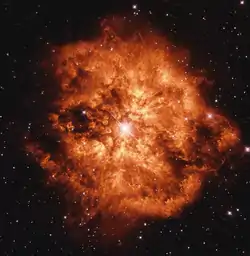M1-67
M1-67 is a planetary nebula that surrounds the Wolf–Rayet star WR 124 which is about 3.35 kpc located in the Constellation of Sagitta. It has dust, which absorbs much of the light that is emitted by WR 124 when it was blown by solar wind. It was discovered by American astronomer Paul W. Merrill in the year of 1938,[1] which he also discovered the star that it surrounds. The size of it is approximately 6 years across, making it about 20,000 years old.
Distance and characteristics
According to a 2010 study that focused on M1-67, it measured the expansion rate by, which was expelled from the star using the Hubble Space Telescope by using Photography, with each photo was taken 11 years apart. After that, the expansion rate was compared to the expansion velocity which was by the Doppler shift of its nebular emission lines, which practically assumes a Geometric Distance of d=3.35 ± 0.67kpc.[2] NASA has confirmed that it was releasing gas that went up to 100,000 mp/h along with approximately 100 Billion-Mile wide glowing blobs, with each blob being around 30 times the mass of the Earth and was blasted around 10,000 years or 10 Millennia ago along with winds moving at 100 km/s, which is causing Turbulence inside it.[3][4] An Infrared study of the Nebula showed that it consists of mildly processed material with number ratios being N/O = 1.0 ± 0.5 and C/O = 0.46 ± 0.27. The Mass of the Nebula's dust has been confirmed to be 0.22 M☉.[5]
| Nebula | |
|---|---|
 The ejection shell that was created 10,000 years ago. The star, WR 124, is visible in the center of the Image. | |
| Observation data: J2000.0 epoch | |
| Right ascension | 19h 11m 30.876s |
| Declination | +16° 51′ 38.168″ |
| Constellation | Sagitta |
There has been a view of the Dynamics on the Nebula and found out that it has been interacting with the surrounding ISM, which caused a Bow Shock inside of it due to a High Velocity of about 180 km/s, making the star or WR 124 about 1.3 Parsecs away from the Bow Shock.[6] The wind had collided with the bow shock shortly after the outburst and were dragged away, which oriented into its main axis, which the evidence was that there was little to no emission found within the Radial Velocities in the centre of the Nebula as seen from Telescopes on earth. The telescopes have found that there was higher Radial Velocities in the center and Lower Velocities near the edges of it, estimating an expansion rate of 150 km/s and Dynamical Timescales of 8 to 20 kyr.[6]
References
- Høg, E.; Fabricius, C.; Makarov, V. V.; Urban, S.; Corbin, T.; Wycoff, G.; Bastian, U.; Schwekendiek, P.; Wicenec, A. (2000-03-01). "The Tycho-2 catalogue of the 2.5 million brightest stars". Astronomy and Astrophysics. 355: L27–L30. ISSN 0004-6361.
- Marchenko, S. V.; Moffat, A. F. J.; Crowther, P. A. (2010-11-20). "Population I Wolf-Rayet Runaway Stars: the Case of WR124 and its Expanding Nebula M1-67". The Astrophysical Journal. 724 (1): L90–L94. arXiv:1011.0785. doi:10.1088/2041-8205/724/1/L90. ISSN 2041-8205.
- "Nebula M1-67 around Star WR124". HubbleSite.org. Retrieved 2021-01-19.
- "Hubble's View of M1-67 Nebula - SpaceRef". spaceref.com. Retrieved 2021-01-19.
- Vamvatira-Nakou, C.; Hutsemékers, D.; Royer, P.; Waelkens, C.; Groenewegen, M. a. T.; Barlow, M. J. (2016-04-01). "Herschel observations of the nebula M1-67 around the Wolf-Rayet star WR 124". Astronomy & Astrophysics. 588: A92. doi:10.1051/0004-6361/201527667. ISSN 0004-6361.
- "INSPIRE". inspirehep.net. Retrieved 2021-01-19.
